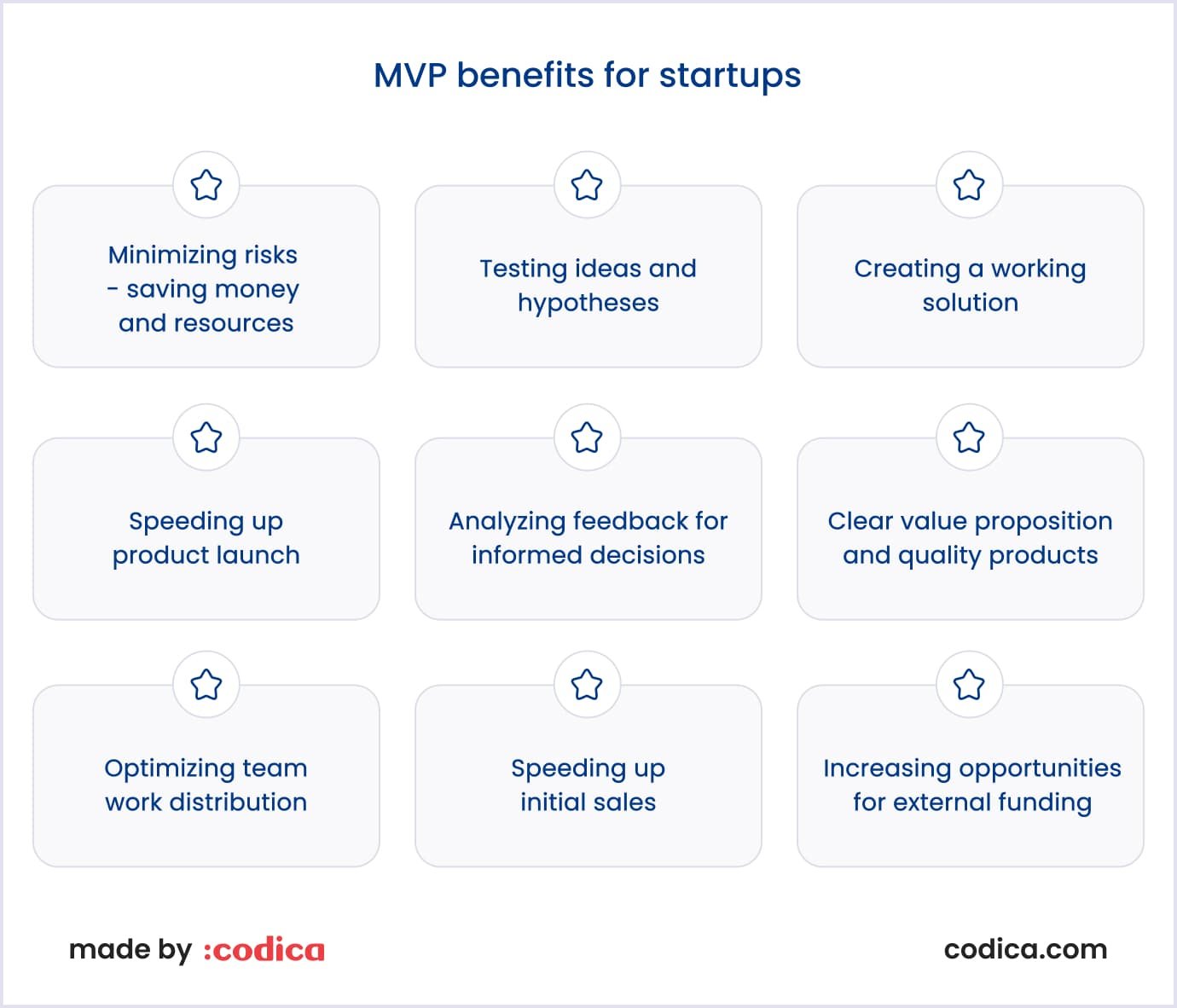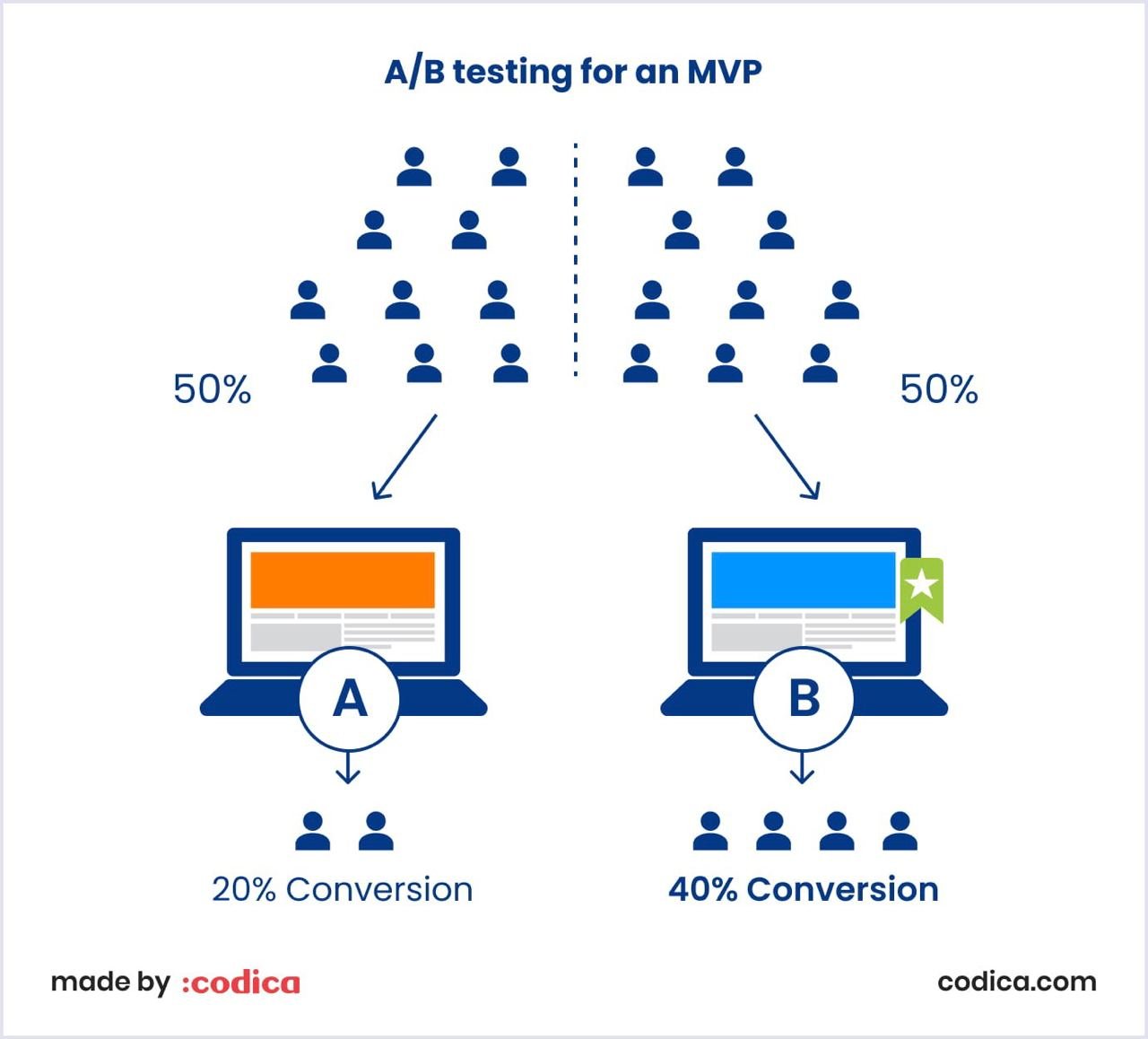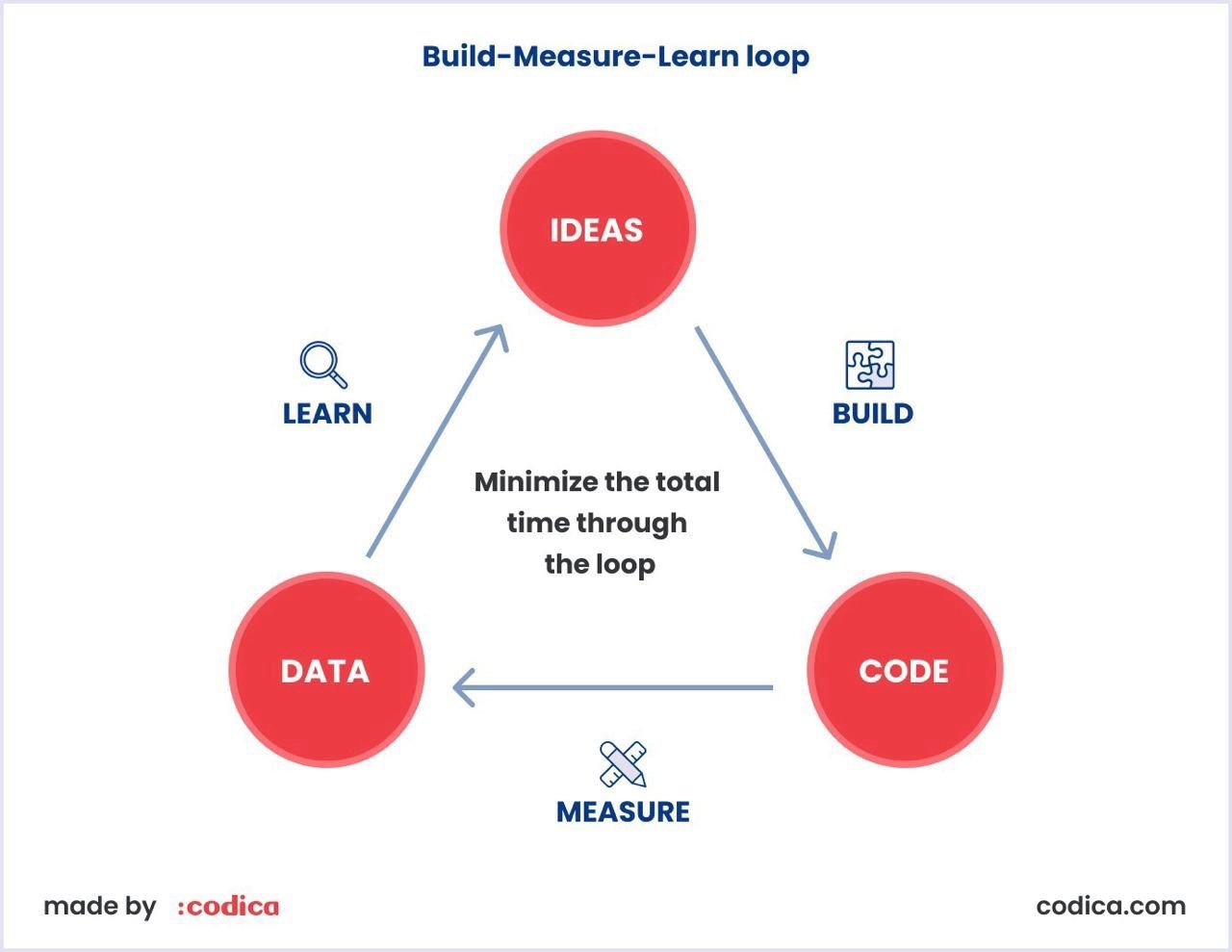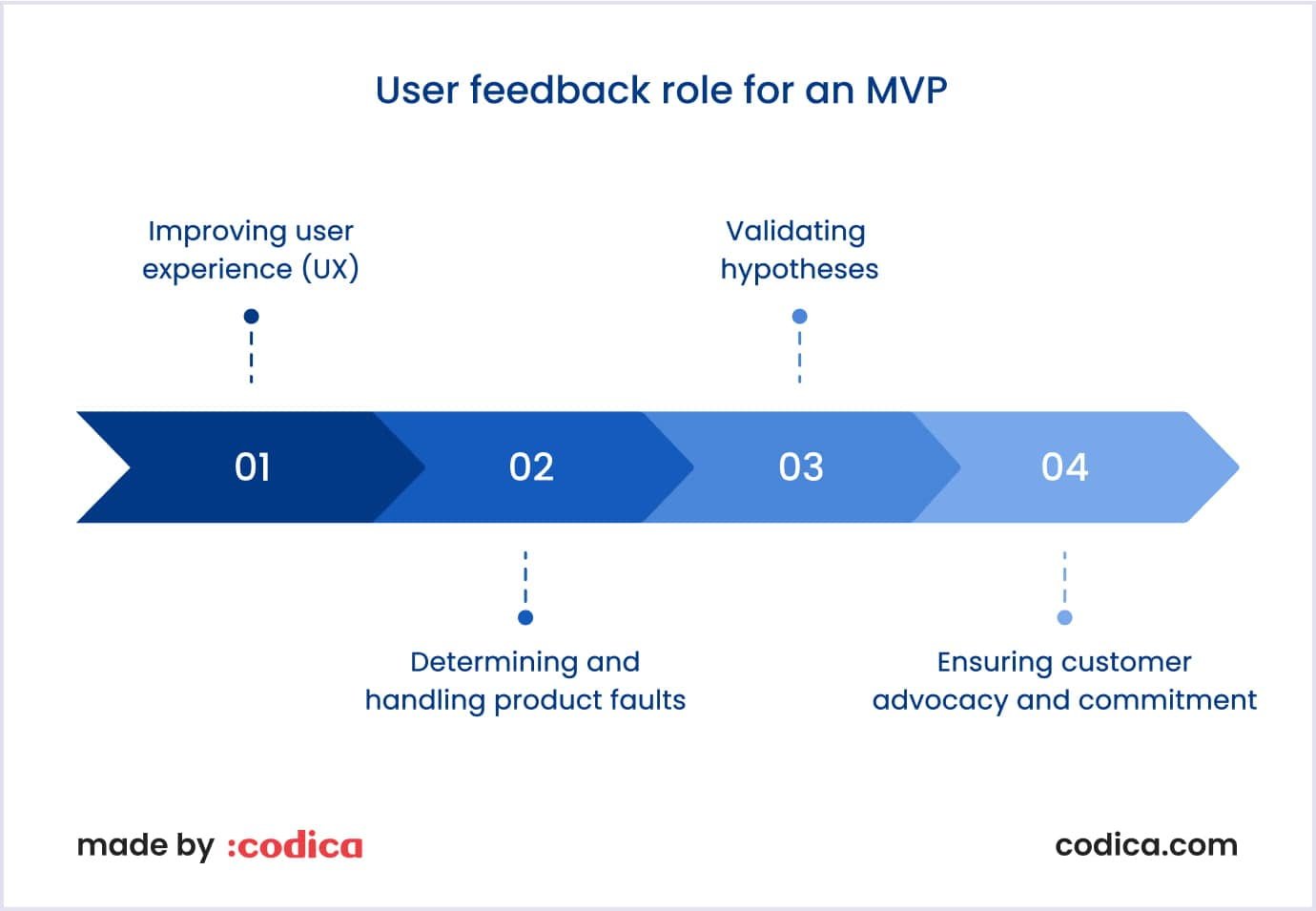The MVP, or minimum viable product, is like a reliable compass for ambitious businesses. It is not just a product launch strategy but an intelligent approach to testing and finding the right course for your preliminary product. Think of it as an innovative way for startups to dip into the market.
In a world where speed and adaptability matter, understanding the MVP benefits is like unlocking the secret to startup success. So, let’s analyze the simplicity and brilliance of MVP, where startups learn to thrive by keeping it savvy and straightforward.
Let’s begin!
Top 10 benefits of building an MVP for startups
First, it is vital to discover why startups need to build an MVP. These startups find MVPs as the secret weapon aiming to survive and shine in the world of business adventures. Let’s delve into the pivotal advantages of startup MVP development.

Minimizing risks - saving money and resources
Creating a minimum viable product has clear advantages in saving money and being budget-friendly. By focusing only on essential features and putting less important ones aside, you can lower the cost of developing an MVP. This approach allows you to spread expenses by working on critical aspects in stages.
The whole process requires minimal resources, from designing to developing the MVP. This helps teams test their ideas in the market without committing to large projects immediately. Creating only the most essential product features during the MVP stage saves various resources, reducing development time and costs. So, think of it as a seat belt holding you back from investing too much in a complete product.
By using an MVP, you also decrease the risks of investing resources in something that may not be wanted or needed. Considering the common reasons for startup failures, like running out of money, the MVP benefits help avoid such pitfalls.
Even if the MVP fails, you’ve avoided significant financial and time-related risks that could have had negative consequences. Why spend unnecessary money on large-scale development when you can choose the less risky path with an MVP? Think carefully!
Testing ideas and hypotheses
A minimum viable product is a great way to test your ideas without investing much upfront. It helps you check your theories about business concepts, market demand, what makes your solution unique, and who your customers are. It also enables you to understand design preferences, expected features, marketing strategies, and pricing.
Using different MVP testing methods, you can gather data on crucial things, like whether users want your product or if they accept it. You can also find and fix any problems or issues to make the product better for users.
In simple terms, an MVP is a quick way to see if your product idea will work in the market. Whether you are just starting the project or working on the next version, the MVP method helps you make decisions based on data from the beginning. This way, you can decide the best direction for your product and reduce the risks of creating something that doesn’t meet expectations.
Below is an example of A/B testing for a successful MVP for startups

Creating a working solution
In simple terms, a minimum viable product is a basic version of a product that actually works but has only a few features. It is like an early version that does not need a lot of money or time to make, but it has to be of good quality, without errors, and look nice.
You can use different things to check if your idea is good, like fake doors, demos, or prototypes. But for it to be a real MVP, it must solve a problem for users. The idea is to learn from the data, make changes, and gradually make the product better.
The iterative nature of MVP development for startups encourages constant refinement based on user feedback. This creates a continuous improvement cycle, allowing teams to enhance and expand the product in alignment with user needs and market demands. An MVP serves as the initial blueprint, laying the foundation for a robust, scalable solution that evolves with precision.

Speeding up product launch
It is important to understand that another company can release a similar product before you. The industry moves quickly, so being the first to enter the market can give you an advantage.
There are also other benefits of building an MVP. It helps companies launch their product faster and get it into the hands of users sooner. Many successful companies have benefited from this approach, choosing to release an early version of their product instead of waiting to build a complete solution.
By reducing the time it takes to launch a product, teams can receive feedback faster. This helps in decision-making and leads to better development choices. Additionally, using MVP tools can speed up product development, offering efficient alternatives to fully fledged products from the start.
Facilitating incremental progress in product development
Agile MVP development for startups follows a lean approach and focuses on doing things in smaller steps. It uses a build-measure-learn model to create basic versions of products. The key is to keep improving and refining the product based on feedback and data.

The goal is to gradually update the product with new features to meet the needs of the target audience better. Each update makes the MVP better, like a phenomenon rising from ideas, standing out from competitors, and becoming something people want to use again.
Analyzing feedback for informed decisions
Among many MVP benefits, delivering an MVP allows you to attract early users who like trying new things. If your product is good, these early users may become fans, giving you feedback, telling others about your product, and increasing your user base.
Think about any problems or challenges users might face. Are users interested in your solution, and is it easy to use? Analyzing feedback helps your product grow. You can find out the following:
- If your product is what your target audience likes;
- How good the user experience (UX) is;
- What customers want and don’t like;
- What needs fixing;
- What strategies are working or not;
- What are current trends in early adopters’ preferences;
- How to continue creating the product to meet market demand.
Doing this lets your product get into the market faster, and your team can learn essential things from accurate data instead of guessing. For example, you might find out if you were wrong about something or if you need to change your business plan. This knowledge helps you stand out and attract more customers.

Clear value proposition and quality products
In a nutshell, when teams focus on solving a specific problem for users, the MVP turns into something people like. By addressing users’ central issues, even a simple yet good product that solves a fundamental problem gets appreciated, leading to the success of the MVP.
The team needs the proper knowledge and tools to create a quality product. That’s why many startups and big businesses seek help from MVP development companies with expert teams.
Highlighting the MVP benefits, a well-aligned core of a minimum viable product can eventually grow into a larger and more complete version, like a minimum lovable product. It can adapt to changes in the market and what the audience wants.
Optimizing team work distribution
A thoughtful way to launch a minimum viable product really helps to use resources wisely. By concentrating on the most critical features, teams spend their time on what really matters and leave less important parts for later.
This focus on choosing the right features stops wasting valuable resources. It means teams don’t spend time creating useless features, and the company uses resources more efficiently, like money for salaries. Clearly, these are significant benefits of building an MVP.
Speeding up initial sales
Making money early on is crucial when developing a product. It helps teams keep progressing with their plans and roadmap. If the initial version of the product, called the MVP, gains traction, early customers might buy it or support it in pre-sales campaigns.
Getting money early indicates that you are heading in the right direction. It shows you are finding a fit in the market or making good choices about how to make money. The funds you collect can not only support ongoing development but also validate that people see value in your product.

Increasing opportunities for external funding
In fact, funding for your product or startup can be challenging, with many others seeking financial support. So, you need to analyze how you can secure financing, especially in the early stages. The key is to build confidence by having a functional MVP.
When you pitch your idea, having a tangible product, even if it’s in its early stages, increases your chances of success. Investors and venture capitalists (VCs) are more likely to consider teams that can show a working solution gaining traction. If you’re pitching just a concept without a tangible product, it may be too risky for investors. Providing transparency and data to support your pitch is crucial in convincing them.
You can watch our video below, where you will find even more exciting information about the MVP benefits.
Conclusion
In summary, using the minimum viable product method can be a game-changer for startups MVP. It’s not just about saving money – it’s a smart way to learn from users, reduce risks, and speed up development.
Beyond all that, working with MVP encourages a mindset of always getting better. Learning from each version of the product helps teams improve and adapt, building a strong foundation for long-term success.
At Codica, we specialize in delivering robust MVP development services. Let us be your tech partner on the journey to success – contact us today and visit our portfolio to explore how we can transform your vision into a robust and market-ready MVP.
